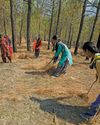
AMID THE refreshing breeze caressing Zanzibar's Jambiani coast, Hindu Rajabu wades through knee-deep water to a lagoon. Wearing swimming goggles and a snorkel perched on her headscarf, the 31-year-old mother of two cautiously navigates the Indian Ocean to locate her floating sponge farm.
Rajabu is among a handful of women in Jambiani village who in 2020 started to cultivate natural sponges. These fascinating animals are made of loosely arranged cells that surround a skeleton of fibres. The specialised cells, nestled within thousands of tiny chambers, act as microscopic pumps, tirelessly drawing water into the sponge's body with their whip-like tails. This unique pumping mechanism, which helps sponges extract nutrition and oxygen, also purifies the ocean water by removing impurities, including sewage. These sponges are also used for bathing and general hygiene because they are naturally antibacterial and antifungal and can resist odours.
With the tide gently rising, Rajabu submerges herself to reach the buoys cradling the sponge farm. Carefully, she inspects the sponges, suspended from thick polyethylene ropes. Using a knife, she removes any fouling organisms, such as bacteria and fish, which have attached themselves to the ropes. This periodic cleaning is essential to prevent the sponges from being overwhelmed by these unwanted inhabitants. The sponge farms are made of multiple ropes that run parallel to each other. They have sponges at different development stages. "We usually harvest them once a week when we collect the sponges that are big enough to be sold in the market," says Rajabu. Women typically dive deep into the ocean to collect healthy wild sponges, which serve as the foundation for their farms that are set up close to the seashore where water is up to two metres deep. These sponge colonies are then carefully cultivated and fragmented to promote new growth.
This story is from the {{IssueName}} edition of {{MagazineName}}.
Start your 7-day Magzter GOLD free trial to access thousands of curated premium stories, and 9,000+ magazines and newspapers.
Already a subscriber ? Sign In
This story is from the {{IssueName}} edition of {{MagazineName}}.
Start your 7-day Magzter GOLD free trial to access thousands of curated premium stories, and 9,000+ magazines and newspapers.
Already a subscriber? Sign In

THE CIRCULARITY ARGUMENT
A circular economy can help India achieve its developmental aspirations while following the low-carbon pathway. It will also help address the challenges of waste management, pollution and overexploitation of natural resources. Industries are already innovating to reuse high-volume wastes and have shown that the transition can usher in both environmental and financial windfalls

Banking on flawed drug voluntary licences
The Medicines Patent Pool is pushing for more VLs, but its bad deal with Novartis on a cancer drug shows the pitfalls

Lasting solutions
For the first time, the UN has recognised the role of indigenous communities in tackling aridity. A repository of traditional knowledge India has the wherewithal to lead the way

IMD at 150
India's journey into modern weather forecasting took a decisive turn 150 years ago with the establishment of India Meteorological Department during the British rule. The agency has come a long way since then, shaping the way the country predicts and responds to its diverse climate challenges

Every drop counts
In drought-prone Marathwada region, 14 villages have managed to counter water shortage by budgeting the resource

Threat to survival
Hollongapar Gibbon Sanctuary in Assam faces ecological challenges as railway electrification and hydrocarbon exploration endanger its fragile biodiversity

'Migration is going to be a battlefield'
AMITAV GHOSH is one of the foremost chroniclers of our times. His literary sojourn includes writings on topics that range from languages to climate change to human lives. His latest book, Wild Fictions, brings some of his works on these issues under one title. In a conversation with RAJAT GHAI, Ghosh shares his views on the future of human movement. Excerpts:

Face of future
California wildfires confirm forest fires are intensifying in a hotter world, emitting substantial amounts of greenhouse gases and reinforcing global warming

Friends of the forest
Residents of 30 villages in Uttarakhand establish a model for public participation in saving forests from wildfires

Climate-crazy playbook
Just hours after his second (and final) term began on January 20, US President Donald Trump unleashed 46 presidential actions. Several of these are centred on the US' climate commitments, energy transition, migration and trade policies, and are likely to have negative global implications